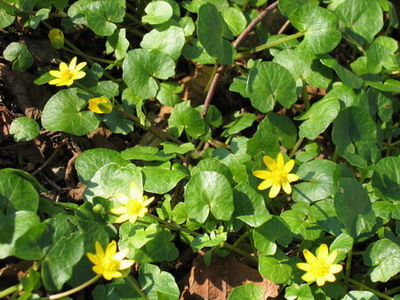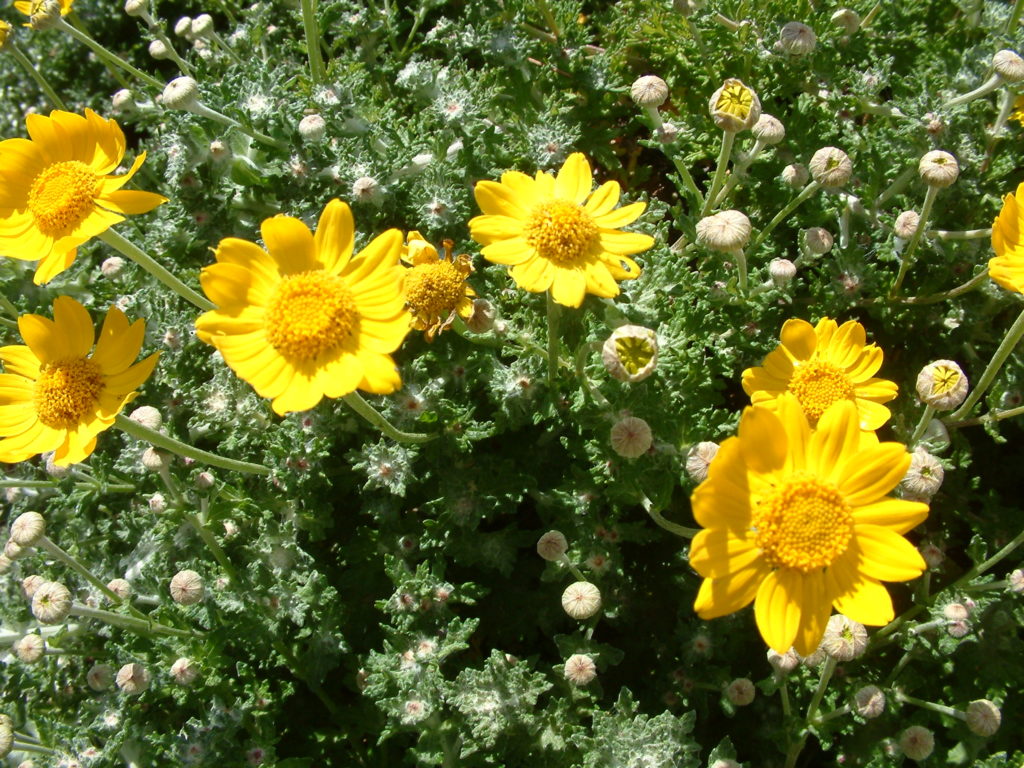Weed of the Month: Lesser celandine (Ficaria verna, formerly Ranunculus ficaria)
Characteristics: Lesser celandine, also known as fig buttercup, is an herbaceous, perennial plant. Plants have a basal rosette of dark green (often mottled with white or silver), shiny, stalked leaves that are kidney- to heart-shaped; these appear in late winter in the Portland area. The glossy, butter-yellow flowers open in March and April, and are borne singly on delicate stalks that rise above the leaves. After flowering, all above-ground portions of the plant die back. Pale-colored bulbils are produced along the stems of the above-ground portions of the plant, but are not apparent until late in the flowering period. Below ground, a dense mass of fibrous roots and tubers holds the plant in place and promotes vegetative spread.
NOTE: This plant closely resembles marsh marigold (Caltha palustris), a native wetland species. Marsh marigold flowers are on stalks at least 8” long, and the plant does not form solid monocultures or bulbils on the stems. Be careful not to confuse these species.
Spread: Lesser celandine spends much of the year (summer through early winter) underground as thickened, fingerlike tubers or underground stems. It spreads primarily by vegetative means through abundant tubers and bulbils, each of which is ready to become a new plant once separated from the parent plant. The tubers of lesser celandine are prolific and may be unearthed and scattered by the digging activities of some animals, including well-meaning weed pullers, and transported during flood events. Large infestations appear as a green carpet with yellow dots, and can cover acres of forest floor (or yard). Lesser celandine readily colonizes forest understories and other habitats with moist soil; its dense, early-season growth smothers native spring ephemeral wildflowers, while its early senescence leaves large bare patches behind, which other weedy species can colonize. All parts of the plant are toxic to mammals when raw, though it does have some medicinal uses.
Control: Lesser celandine is very difficult to control but it can be managed with persistence over time using methods that are site-appropriate. For small patches, lesser celandine may be pulled up by hand or dug up using a hand trowel or shovel. It is very important to remove all bulbils and tubers; digging up the top several inches of soil around the infestation and screening it may help with this. For larger infestations, the use of systemic herbicide is more practical, killing the entire plant tip to root and minimizing soil disturbance. The window of opportunity for controlling lesser celandine is very short, due to its life cycle. In order to have the greatest negative impact to celandine and the least impact to desirable native wildflower species, herbicide should be applied in late winter (February/early March). Contact the Oregon Department of Agriculture for advice on appropriate use of herbicides.
Whatever you do, don’t mow lesser celandine! Remember all those bulbils on the flower stalk? Mowing flings them every which way, helping the plant spread. If you’ve seen a yard carpeted in lesser celandine, it’s a good bet that was mowed by an unsuspecting gardener or landscaper.
Replacement species: For an open area, Oregon sunshine (Eriophyllum lanatum) is a drought-tolerant, spreading native that attracts a variety of beneficial insects and butterflies. For shady, moist areas, stream violet (Viola glabella) would make an excellent replacement for lesser celandine.
Click HERE for even more information on Lesser Celendine!


Images courtesy of http://vorort.bund.net/koenigstein-glashuetten/aktuell/aktuell_2/files/1165_scharbockskrautklein.jpg (celandine) and
https://www.google.com/search?q=eriophyllum+lanatum&rlz=1C1CHBF_enUS841US841&source=lnms&tbm=isch&sa=X&ved=0ahUKEwjf3P_Xj7DhAhUQ-lQKHeXnCk4Q_AUIDigB&biw=1280&bih=610#imgrc=1rGubQUXmSTl7M: (Oregon sunshine)
